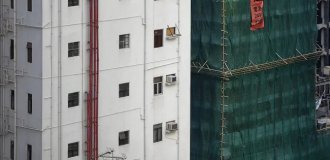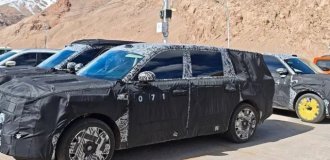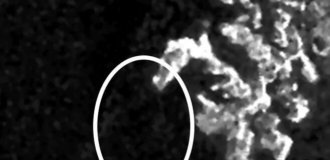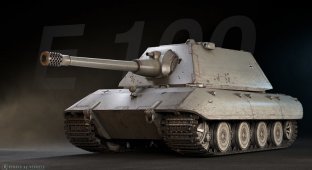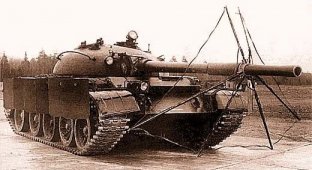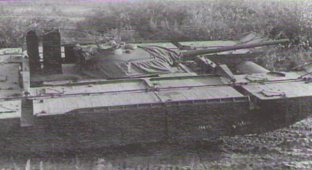The IS-7 was by far the most powerful tank of its time in the world. In terms of the totality of its characteristics, it was significantly superior to all existing and even promising machines at that time. But the plans of the military-political leadership for a nuclear missile conflict buried the very concept of such a powerful and expensive tank. The bet was placed on hordes of cheap medium tanks.

One of the best
The Soviet IS-7 heavy tank was supposed to absorb all the experience of World War II and become a combat vehicle that was head and shoulders above all existing ones. It received excellent protection, powerful weapons and was able to move almost at the speed of a medium tank. The IS-7 was developed in an extremely short time, creating more than 1,500 drawings, using more than 25 innovative ideas that were not typical for tank building, and involving more than 20 scientific institutions.
But for some reason, this innovative tank did not become the basis of the Soviet armored forces; moreover, not a single one of the 50 IS-7 samples ordered left the factory gates.

Creation
To create the IS-7, designers were brought in who gained a lot of experience during the design of heavy tanks. Chief designer Kotin headed this work, which began in 1945. Then three options were being studied, namely object 257, 258 and 259. Their difference was in the engine and transmission.
Later, in the summer of 1945, another version appeared - object 260, which later became the IS-7.
On September 9, the drawings were signed by Kotin, but in 1946 they decided to change the tank without changing the index.
The first sample was supposed to use an electric transmission and two V-16 diesel engines.
The second, which became the final one, featured a more traditional power plant.
On September 8, 1946, the first sample was assembled, which showed compliance with the requirements during testing. On December 25, the second one was assembled.
The chief tester, Kulchitsky, was delighted with the ease of control of the new machine, whose weight reached 68 tons.
The armor of the IS-7 was not penetrated even by its own gun; during one of the tests, dogs were placed inside, which were completely unharmed by the shelling.
However, there were also negative aspects such as a fire due to an exhausted engine and destruction of the suspension due to shelling.
The IS-7 turned out to be very successful, but, for unknown reasons, the production of the first experimental batch was constantly postponed; later it was proposed to reduce its weight to 50 tons, which was impossible for the given characteristics. As a result, mass production never began, and today only one copy of the IS-7 remains, standing in the museum in Kubinka.


Design and layout
It was assumed that the tank would become truly innovative, thanks to the combination of its tactical and technical characteristics.
Weighing 68 tons, roughly the same as the King Tiger, the IS-7 was far superior in protection, mobility and firepower, arriving just 2 years later. This was made possible thanks to highly differentiated armor located at significant angles and solutions such as the pike nose.
The tank was created according to the classic layout scheme, with a driver at the beginning of the hull, a turret accommodating the remaining 4 crew members in the middle and an engine and transmission compartment at the rear. The drive wheels and transmission were also located at the rear.
The hull and turret had a very unusual shape, originating from the IS-3, and provided a large reduced armor thickness along with good chances of ricochet.




Frame
To ensure maximum protection, as the experience of World War II and the T-34 showed, it is necessary to place the armor at an angle. On the IS-3 they went even further and not only placed the upper frontal plate at an angle, but also divided it into two parts, inclined towards each other. This shape provided greater protection than one rectangular piece of armor from fire to the forehead and was called the “pike nose.”
The IS-7 also received the same forehead, made of two 150 mm thick sheets installed at an angle of 65°. Thanks to the shape, the reduced armor thickness reached 260 mm. Thus, the IS-7 became the first tank capable of withstanding a shot from the German PaK 44 L/55 128 mm gun mounted on the Jagdtiger. Also, it could withstand its 130 mm S-70 gun. The lower armor plate had a thickness of 150 mm and was located at an angle of 50°.
The sides were of a complex curved shape, and, for greater strength, they were bent with a press, and consisted of an upper part, 150 mm thick, and a lower part, concave inward, 100 mm thick.
The stern also had a complex curved shape and consisted of two parts - the top 60 mm and the bottom 100 mm.
The body contained rubber tanks capable of withstanding a pressure of 0.5 atm and a total capacity of 1300 liters.


Tower
The first prototypes had a turret very similar to that installed on the IS-3, but was later changed.
It became more flattened and armored, made using casting, the thickness gradually changed, from 210 mm at the forehead to 94 at the rear, with a variable slope of 51° - 60°. They also installed a very durable gun mantlet, 355 mm thick.
4 crew members were located inside the turret - two loaders at the rear of the turret, a gunner to the left of the gun and a commander to the right.



Armament
As a weapon, the tank was first equipped with an S-26 cannon with a caliber of 130 mm, 3 DT machine guns and 2 KPV.
Later, the gun was changed to an S-70 of the same caliber, with an initial projectile speed of 900 m/s and 8 machine guns.
A fire control device appeared, which made aiming the sight independent of the position of the gun. The gunner indicated the aiming point, after which the stabilized gun was automatically aimed at the desired location.
Another new feature was the shell conveyor, which made the crew’s work easier. Thanks to him and 2 loaders, the rate of fire of the IS-7 reached 8 rounds per minute.
3 machine guns were installed in the cannon mantlet, 2 RP-46s on the fenders, two more on the rear of the turret, and there was also an anti-aircraft gun mounted on a rod attached to the roof of the turret. All of them were remote controlled and aimed by loaders.
The cannon's ammunition consisted of 30 shells, the machine guns - 400 large-caliber and 2,500 small-caliber cartridges.



Engine and transmission
At the very beginning, several options for the power plant were studied, for example, consisting of 2 V-16 diesel engines with a power of 1200 hp. and electric or mechanical transmission.
Later, a serial and proven M-50T diesel engine with a power of 1050 hp was installed on the tank. Its disadvantage was that it was intended for sea boats, and therefore had rather large dimensions.
The IS-7 was equipped with an ejector cooling system, a first for Soviet tank construction, and an inertial air filter.
The transmission was not unnecessarily complicated and remained a conventional mechanical one. The tester later recalled that changing gears was very easy, as was the control of the tank as a whole.
They also installed an automatic fire extinguishing system, created by Shemelin, which monitored the state of the equipment using sensors and could be turned on up to 3 times, however, during testing, one tank completely burned down without being able to be extinguished.

The tank's transmission was designed in two versions. The first, manufactured and tested in the IS-7, had a six-speed gearbox with carriage shifting and synchronizers. The rotation mechanism is planetary, two-stage. The control had hydraulic servos. During testing, the transmission showed good traction qualities, ensuring high average speeds of the tank.
The second version of the mechanical transmission was developed jointly with the Moscow Higher Technical School named after N.E. Bauman. Transmission - planetary, 8-speed, with a ZK-type turning mechanism. Control of the tank was facilitated by hydraulic servos with advanced gear selection.
When developing the chassis, the design department designed a number of suspension options, manufactured and subjected to laboratory running tests on production tanks and on the first experimental IS-7 tank. Based on them, final working drawings of the entire chassis were developed.
For the first time in domestic tank building, tracks with a rubber-metal hinge (or, as they said then, with a silent block), double-acting hydraulic shock absorbers, road wheels with internal shock absorption operating under heavy loads, and beam torsion bars were used.

Chassis
Due to the large dimensions of the engine, the housing would be too high with a traditional suspension. Therefore, beam torsion bars were developed, which provided the hull height even less than that of the IS-2 and IS-3.
The idler wheel was located at the front, the drive wheel was located at the rear, and there were 7 road wheels between them, while the support wheels were abandoned.
To ensure a smooth ride, hydraulic double-sided shock absorbers were installed on the IS-7.
The caterpillar with rubber-metal hinges and cast tracks was difficult to manufacture, but had good wear resistance and reduced noise.



In the summer of 1948, the Kirov Plant produced four IS-7s, which, after factory testing, were transferred to state production. Major General A.M. Sych was appointed Chairman of the State Commission. The tank made a strong impression on the commission members: with a mass of 68 tons, the vehicle easily reached a speed of 60 km/h and had excellent maneuverability.
Let's look at the IS-7 in comparison with the post-war generation of tanks. The main tanks in NATO's arsenal at that time were the British Centurion and the American Patton. Their armament consisted of 83.2mm and 90mm guns with a high muzzle velocity. (Both later received a 105mm gun.) To counter the IS-3 abroad, two heavy tanks were created - the M-103 and the Conqueror, equipped with a 120mm gun with an muzzle velocity of 1000m/ With. The frontal armor of the IS-7 was invulnerable to armor-piercing shells from heavy tanks at a distance of over 1000m. The side protection withstood hits from medium tank shells. During testing, the armor protection of the IS-7 showed incredible ballistic resistance for that time. It withstood hits from a German 128mm gun and even its own 130mm. During the war, a 128mm gun hit any tank at any distance, including. IS-2. The IS-7's own gun had a caliber of 130mm and a muzzle velocity of 900m/s and had armor penetration of over 185mm at a distance of 1.5km. The main problem of large-caliber guns - rate of fire - was solved. Using the loading mechanism and the introduction of two loaders into the crew, a rate of fire of 6-8 rounds per minute was achieved. The sighting system was also significantly improved; the tank was capable of fighting at long range with extreme accuracy. Thus, the IS-7 could destroy any type of NATO tanks while being outside their affected area. During the Second World War, heavy tanks, while superior to average in combat characteristics, were significantly inferior to them in mobility. This problem was solved by installing a 1000-horsepower engine and the latest transmission with servos. Its armor protection at that time was practically invulnerable. Suffice it to say that the IS-7 withstood fire not only from a 128 mm German cannon, but also from its own 130 mm gun.
During the tests, an interesting experiment was carried out to determine the effect on the crew of direct hits from artillery shells into the tank. Dogs were placed in the crew's seats, after which the IS-7 was subjected to fire. However, the results of the shelling had no effect on the condition of the animals.
Let's look at the IS-7 in comparison with the post-war generation of tanks. The main tanks in NATO's arsenal at that time were the British Centurion and the American Patton. Their armament consisted of 83.2mm and 90mm guns with a high muzzle velocity. (Both later received a 105mm gun.) To counter the IS-3 abroad, two heavy tanks were created - the M-103 and the Conqueror, equipped with a 120mm gun with an muzzle velocity of 1000m/ With. The frontal armor of the IS-7 was invulnerable to armor-piercing shells from heavy tanks at a distance of over 1000m. The side protection withstood hits from medium tank shells. During testing, the armor protection of the IS-7 showed incredible ballistic resistance for that time. During the war, a 128mm gun hit any tank at any distance, including. IS-2. The IS-7's own gun had a caliber of 130mm and a muzzle velocity of 900m/s and had armor penetration of over 185mm at a distance of 1.5km. The main problem of large-caliber guns - rate of fire - was solved. Using the loading mechanism and the introduction of two loaders into the crew, a rate of fire of 6-8 rounds per minute was achieved. The sighting system was also significantly improved; the tank was capable of fighting at long range with extreme accuracy.
Thus, the IS-7 could destroy any type of NATO tanks while being outside their affected area. During the Second World War, heavy tanks, while superior to average in combat characteristics, were significantly inferior to them in mobility. This problem was solved by installing a 1000-horsepower engine and the latest transmission with servos. The huge 68-ton tank accelerated to 60 km/h and was easily controllable. The M-103 and "Conqueror", while being more or less adequate in armor protection and armament to the IS-7, were significantly inferior to it in speed and mobility. To combat unarmored targets and infantry, our tank also had extremely powerful small arms. As a result, the USSR could receive a prototype of a modern main tank that would devalue the tank arsenals of a potential enemy. Unfortunately, the progress of anti-tank, nuclear weapons and aviation has called into question the concept of the “ideal” tank. Improvements in cumulative ammunition have sharply reduced the value of its powerful ballistic armor protection.
Such revolutionary innovations in tank design also suffered from military production culture and a lack of technological base. The engine constantly broke down, the fire extinguishing system did not work, the transmission could hardly withstand the load, and there were other “childhood diseases.” Of course, all these excellent characteristics came at the cost of an exorbitant mass of 68 tons, which resulted in a sharp reduction in operational mobility.
Transportation of a tank of such mass was not provided for in the Soviet army, however, the Germans were quite capable of transporting the 68-ton “Royal Tiger” and the 72-ton “Jagdtiger”.

Epilogue
The IS-7 tank turned out to be truly unique. It had unsurpassed protection, a powerful weapon and excellent mobility, but the era of heavy tanks was coming to an end. Their place would soon be replaced first by medium tanks, then by MBTs.
If the IS-7 had appeared at another time or in another country, whose leadership would not have been afraid to put it into production, it would have become the best in the world, surpassing all modern tanks in key characteristics, but history does not tolerate the subjunctive mood.



[media=https://www.youtube.com/watch?v=lirzeF9P1-o]

